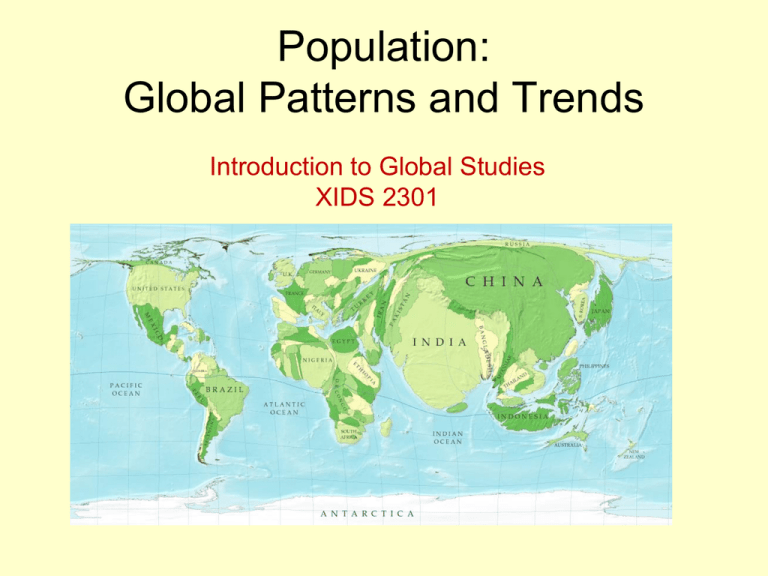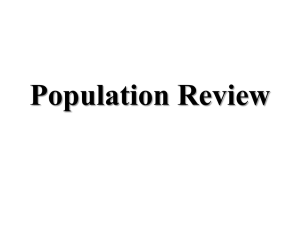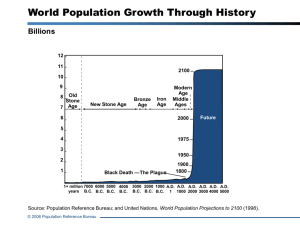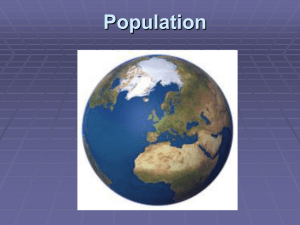Slide 1
advertisement

Population: Global Patterns and Trends Introduction to Global Studies XIDS 2301 The light blue line shows that between 2005 and 2007, food prices have increased by more than 50%. • Farmers protest Thus, a basket of food that cost $20 in • Food riots 2005 cost more than $30 in 2007. • http://www.nytimes.com/2008/04/18/world/ americas/18food.html How does “population” account for the rising demand for food in the “developing world”? World Population Clock 2005 Natural Increase per More Developed Countries World Less Developed Countries Less Developed Countries (less China) Year 80,794,218 1,234,907 79,559,311 71,906,587 Day 221,354 3,383 217,971 197,004 154 2 151 137 Minute Source: Population Reference Bureau, 2005 World Population Data Sheet. World Population Growth (in billions) Population: Global Patterns and Trends 1. Size 2. Growth 3. Distribution 4. Composition Population: Global Patterns and Trends 1. Size World Population Growth Through History (in billions) 12 11 2100 10 9 Old Stone 7 Age 8 New Stone Age Bronze Age Iron Age 6 Modern Age Middle Ages 2000 Future 5 4 1975 3 1950 2 1 Black Death —The Plague 1900 1800 1+ million 7000 6000 5000 4000 3000 2000 1000 A.D. A.D. A.D. A.D. A.D. A.D. years B.C. B.C. B.C. B.C. B.C. B.C. B.C. 1 1000 2000 3000 4000 5000 Source: Population Reference Bureau; and United Nations, World Population Projections to 2100 (1998). World Population Growth Number of years to add each billion (year) 130 (1930) Second Third Fourth 30 (1960) 15 (1975) Fifth 12 (1987) Sixth 12 (1999) Seventh Eighth Ninth (1800) All of Human History First Billion 14 (2013) 14 (2027) 21 (2048) Sources: First and second billion: Population Reference Bureau. Third through ninth billion: United Nations, World Population Prospects: The 2004 Revision (medium scenario), 2005. World Population Growth (in billions) Population: Global Patterns and Trends 2. Growth Principal components of population growth: --Natural Increase --Net Migration Birth and Death Rates, Worldwide Rates of birth, death, and natural increase per 1,000 population 40 35 30 25 Natural Increase 20 15 10 5 0 1950- 1955- 1960- 1965- 1970- 1975- 1980- 1985- 1990- 1995- 20001955 1960 1965 1970 1975 1980 1985 1990 1995 2000 2005 Birth rate Death rate Source: United Nations, World Population Prospects: The 2004 Revision, 2005. The Classic Stages of Demographic Transition Stage 1 Stage 2 Stage 3 Birth rate Natural increase Death rate Time Note: Natural increase is produced from the excess of births over deaths. Stage 4 Population: Global Patterns and Trends 2. Growth Principal components of population growth: --Natural Increase BR, DR; also TFR --Net Migration (immigration, emigration) Every Country Has a Different Pattern of Fertility Decline. Fertility Patterns for Selected Countries: 1950-2010 Sources: United Nations Population Division, World Population Prospects: The 2006 Revision; Population Reference Bureau; and Korea National Statistics Office. © 2008 POPULATION REFERENCE BUREAU Total Fertility Rates (2000-2005) Association Between Fertility and Poverty Percent of Population Living on <$2 per Day 100 Niger Mongolia 80 60 40 20 Jordan 0 0 1 2 3 4 5 6 7 Total Fertility Rate Source: Population Reference Bureau, Population & Economic Development Linkages 2007 Data Sheet. 8 Association Between Fertility and Education Percent of Girls Enrolled in Secondary School Uruguay 120 Palestinian Territory 100 80 60 Morocco 40 20 0 0 1 2 3 4 5 6 7 Total Fertility Rate Source: Population Reference Bureau, Population & Economic Development Linkages 2007 Data Sheet. 8 Association Between Fertility and Employment Female Labor Force Participation Rate 2004 100 80 Djibouti 60 Philippines 40 Turkey 20 0 0 1 2 3 4 5 6 7 8 Total Fertility Rate 2000-2004 Source: United Nations, World Population Prospects: The 2004 Revision, 2005; International Labor Organization, Yearbook of Labor Statistics 2006. Population: Global Patterns and Trends 3. Distribution Map of World Population ~2000 Cartogram adjusts area by some value, such as size of population Population Growth World Population Growth (in billions) Year 1 World Map Year 1 1500 1900 1960 2000 2050 2300 Total Fertility Rates (2000-2005) Total Fertility Rates (1970-1975) Childhood Mortality Among the Poor Poorest Economic Quintile Deaths under age 5 per 1,000 births Nigeria 2003 257 Burkina Faso 2003 206 Cameroon 2004 189 Malawi 2004 183 Kenya 2003 149 Ghana 2003 128 Bangladesh 2004 121 Lesotho 2004 114 Bolivia 2003 Philippines 2003 105 66 Source: ORC Macro, Demographic and Health Surveys. Population Living on Less Than 2002 US$2 per Day Percent 78 75 50 41 23 World South Asia Sub-Saharan Africa Source: World Bank, World Development Indicators 2006. East Asia and the Pacific 20 Latin America Middle East and the and North Caribbean Africa Population: Global Patterns and Trends 4. Composition By 2050, One in Every Five Americans Will Be Age 65 or Older. Percent of U.S. Population in Selected Age Groups: 1970-2050 Source: Population Reference Bureau, analysis of data from U.S. Census Bureau. © 2008 POPULATION REFERENCE BUREAU










